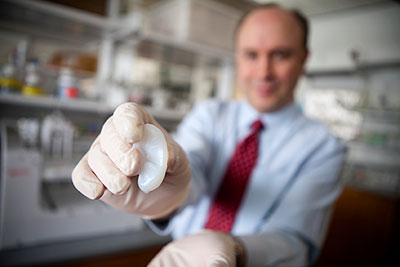
Printing Body Parts – A Sampling of Progress in Biological 3D Printing
Printing Body Parts – A Sampling of Progress in Biological 3D Printing
By IEEE Life Sciences Staff
If you haven’t been living in a low-tech cave for the last few years, you’ve probably heard about 3D printing, a technology that has grown out of the ubiquitous ink-jet printer. Researchers have more recently been making great strides toward using the technology for producing products to be used in the human body. This application is known as ‘bioprinting’ (“the construction of a biological structure by computer-aided, automatic, layer-by-layer deposition, transfer, and patterning of small amounts of biological material”, from Wiktionary.org). One goal of bioprinting is to be able to print biological tissues for regenerative medicine. For example, in the future, doctors may repair the damage caused by heart attack by replacing it with tissue that rolled off of a printer. We have sampled some bioprinting applications that we found of great interest.
One way to gain perspective on the wide range of applications is to work down the size scale from the macro to the micro. Researchers have already implanted some 3D-printer generated structures in human patients. Several bone replacement projects have been reported. In June 2012, surgeons in Belgium implanted a jawbone replacement in a woman suffering from oral cancer and infection. IEEE Spectrum interviewed the founder of the company that created the replacement (Bone Transplantation without Rejection)
Parenthetically, in a somewhat off-beat application, a team at the University of Leicester, UK, recently used a 3D printer to reconstruct the skull of King Richard III (lived 1452-1485), whose bones were recently unearthed in an excavation for a car parking lot. IEEE Spectrum describes the process (3D Printing the Skull of King Richard III). The resulting reproduction was done to facilitate study of the remains, not for human implantation.

Lawrence Bonassar, associate professor of biomedical engineering, and colleagues collaborated with Weill Cornell Medical College physicians to create an artificial ear using 3-D printing and injectable molds. Lindsay France/University Photography
The literature has also reported projects to replace damaged or missing external body parts. Cornell University researchers have fabricated a replacement external ear (Bioengineers. physicians 3-D print ears that look, act real). At the University of Sheffield, an artificial nose has been produced (Creating a new nose using 3D colour printing).
These particular replacements did not contain blood vessels. Achieving vascularization in printed organs is much more difficult than producing a simple mechanical structure. One approach toward achieving vascularization, is underway at the University of California, San Diego (Nanoengineers can print 3D microstructures in mere seconds). At the University of Pennsylvania, a different approach is being studied. A 3D printer is being used to create a dissolvable template. After cells are allowed to grow around this template, it is dissolved, leaving a vascular network. The work is highlighted in the IEEE Spectrum (Scientists Build Vascular Network Using Sugar and a 3-D Printer).
Finally, consider the printing of individual cells or small clumps of cells to form a biological structure. In one instance, researchers at Wake Forest School of Medicine (Printing Skin Cells On Burn Wounds) have been studying the use of 3D printers to print skin cells directly onto burn wounds. The goal of this work is to speed the patient’s recovery and reduce the occurrence of complications.
Another reported research project, at the University of California, San Diego, used 3D printing of cells utilizing embryonic stem cells as the “ink” (A 3-D Printer for Human Embryonic Stem Cells). The long-term objective is to produce a replacement human liver. This would obviously need to address the vascularization problem mentioned earlier.
The projects are only a sampling of the reported work underway to harness 3D printing technology for replacement of biological structures. Stay tuned to the Life Sciences Portal and IEEE publications for updates on this fascinating topic.






